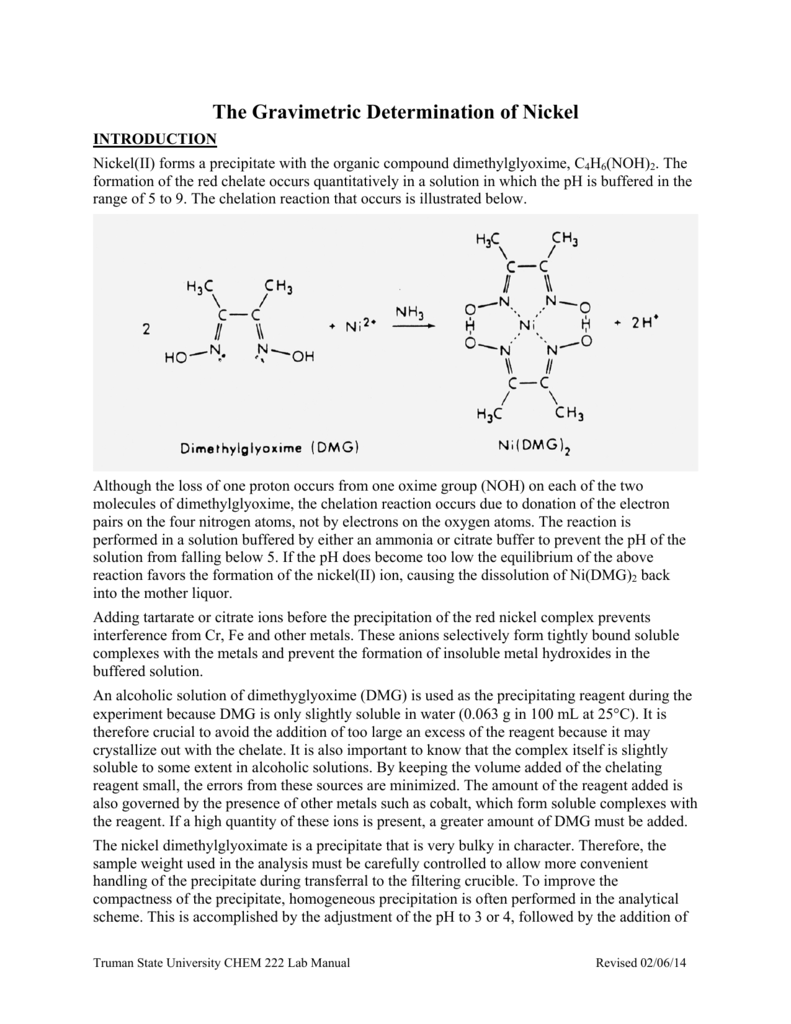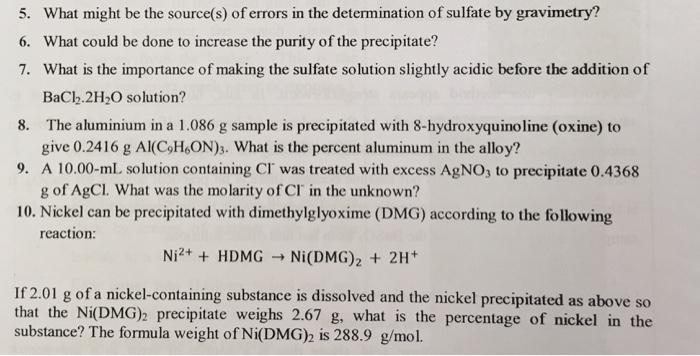Gravimetric Determination Of Nickel Dmg
Summary
Gravimetric method is used whereby dimethylglyoxime (1% in alcohol) is added to precipitate the analyte which is later separated from the solution and dried. The concentration of the sample solution has been calculated as 0.109 mg/mL. Introduction; In this lab, you will be precipitating nickel (Ni2+) from an unknown Nickel ore.
A detailed investigation has been made of the gravimetric determination of nickel with dimethylglyoxime in the presence of copper. Copper interference is eliminated by precipitation in a solution containing tartrate and thiosulphate at a pH of 5.5–6.5. The solubility of the nickel dimethylglyoxime complex has been determined as a function of temperature, pH and alcohol concentration.
This is a preview of subscription content, log in to check access.
Access options
Gravimetric Determination Of Nickel


Buy single article
Gravimetric Determination Of Nickel Dmg 1
34,95 €
Price includes VAT for Germany
Gravimetric Analysis Of Nickel Using Dimethylglyoxime
| Physical Chemistry Virtual Lab Physical chemistry (also called physicochemistry) is the explanation of macroscopic, microscopic, atomic, subatomic, and particulate phenomena in chemical systems in terms of physical concepts; sometimes using the principles, practices and concepts of physics like thermodynamics, quantum chemistry, statistical mechanics and dynamics. Spectrophotometry || Cryoscopy || Ebullioscopy || EMF measurement || Determination of Viscosity of Organic Solvents || Adsorption Isotherm || Verification of Tafel Equation || Determination of Viscosity Average Molecular Weight of Polymer || Calorimetry -Water equivalent Calorimetry || Calorimetry -Heat of Neutralization |
| Organic Chemistry Virtual Lab Organic chemistry is a discipline within chemistry which involves the scientific study of the structure, properties, composition, reactions, and preparation (by synthesis or by other means) of chemical compounds that contain carbon. Detection of Functional Groups || Detection of Elements: Lassaigne鈥檚 Test || Separation of Compounds Using Column Chromatography || Purification by Fractional distillation/crystallisation || Purification by Steam distillation/crystallisation || Laser Flash Photometer || Organic Preparations - Allylation of Isatin || Estimation of Aspirin || Estimation Of Glucose || Calculation of 位max of Organic Compounds Using Woodward Fieser Rules |
| Inorganic Chemistry Virtual Lab Inorganic chemistry is the branch of chemistry concerned with the properties and behavior of inorganic compounds. This field covers all chemical compounds except the myriad organic compounds (carbon based compounds, usually containing C-H bonds). Water analysis-Determination of Physical parameters || Water analysis-Determination of Chemical parameters || Acid Base Titration || Gravimetric Estimation of Barium || Gravimetric Estimation of Nickel || Crystal Field Theory || Group Theory || Alloy Analysis (Brass) || Soil Analysis-Determination of Specific conductivity of Soil || Soil Analysis-Determination of pH of Soil |
| Advanced Analytical Chemistry Virtual Lab Analytical chemistry is the branch of chemistry concerned with studying the properties of materials and development of tools used to analyze materials. It is the science of sampling, defining, isolating , concentrating and preserving samples. Soil Analysis-Determination of Available Organic Carbon content in the Soil || Soil Analysis-Determination of Available Nitrogen content in the Soil by Kjeldahl method || Soil Analysis-Determination of Available Phosphorus content in the Soil by Bray's method || Electrogravimetric Estimation of Metals || Estimation of Phosphate Content in Soft Drinks || Flame Photometry || Polarography - Determination of Unknown Concentration of Cadmium || Polarography - Determination of Unknown Concentration of Vitamin C |